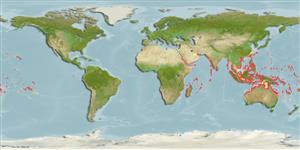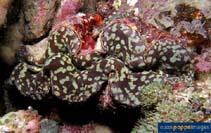Tridacna maxima (Röding, 1798)
Elongate giant clam| Native range | All suitable habitat | Point map | Year 2050 |

|
| This map was computer-generated and has not yet been reviewed. |
| Tridacna maxima AquaMaps Data sources: GBIF OBIS |
Classification / Names প্রচলিত নাম সমূহ | প্রতিনাম সমূহ | CoL | ITIS | WoRMS
Bivalvia | Cardiida | Cardiidae
Environment: milieu / climate zone / গভীরতার পরিসীমা / distribution range বাস্তুসংস্থান
রীফ সংশ্লিষ্ট; অ_ পরিযায়ী (সূত্র 348); ঈষৎ লোনা ; গভীরতার পরিসীমা 0 - 35 m (সূত্র 348). Tropical; 23°C - 30°C (সূত্র 102835); 28°N - 37°S, 31°E - 128°W
Distribution দেশ সমূহ | এফ এ ও এলাকাসমূহ | বাস্তুতন্ত্র | দৃষ্টিগোচর | প্রচলন
Indo-Pacific: Egypt to Pitcairn Islands and Ogasawara, Japan to Lord Howe Island.
Length at first maturity / আকৃতি / Weight / Age
পরিপক্কতা : Lm ?, range 6 - 13 cm Max length : 41.7 cm SHL পুরুষ/ লিঙ্গ অনিধর্ারিত ; (সূত্র 117184); common length : 25.0 cm SHL পুরুষ/ লিঙ্গ অনিধর্ারিত ; (সূত্র 348)
Short description বহিঃ অঙ্গ সংস্থান
Life cycle and mating behavior পরিপক্কতা | প্রজনন | ডিম ছাড়া | Eggs | ডিম্বধারন ক্ষমতা | Larvae
Main reference
সূত্র সংখ্যা | সমম্বয়কারী | সহযোগী
SAUP Database 2006 SAUP Database. www.seaaroundus.org. (সূত্র 356)
IUCN Red List Status
(সূত্র 130435: Version 2025-1)
CITES status (সূত্র 108899)
CMS (সূত্র 116361)
Threat to humans
Human uses
মৎস্য: বাণিজ্যিক
FAO - এ্যাকুয়াকালচার (জলজ পালন) : production; | FishSource | আমাদের চতুর্পাশ্বের সাগর
হাতিয়ার
আরো তথ্য
Max. ages / sizes
Length-weight rel.
Length-length rel.
Length-frequencies
Mass conversion
প্রাচুর্য
ইন্টারনেট সুত্র
BHL | BOLD Systems | CISTI | DiscoverLife | FAO(; publication : search) | Fishipedia | GenBank (genome, nucleotide) | GloBI | Gomexsi | Google Books | Google Scholar | Google | PubMed | জীবন বৃক্ষ | Wikipedia (Go, অনুসন্ধান ) | জুলজিকাল রেকর্ড



